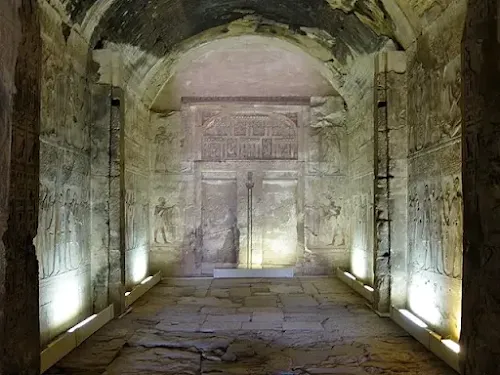Introduction to the Temple of Abydos
It was also a witness to the eternal love story of Isis and Osiris, earning many titles, the most famous of which is “Ta-wer,” meaning “The Great Land.”
Abydos Temple
is one of the most important ancient Egyptian temples.Its unique architectural design, the beauty of its engravings, and the splendor of its colors, in addition to the rare drawings on its walls, have given it a special historical significance.
 |
| Abydos Temple |
The word Abydos is the current name for the capital of Upper Egypt’s regions in the Pharaonic era.
This Greek name is derived from one of its ancient hieroglyphic names, “Ab-ju,” which was a center for the worship of the deity “Khenti-Amentiu” before becoming a major center for the worship of “Osiris.” It is one of the richest archaeological sites in Egypt.
 |
| Sanctuary of Amun-Re in the mortuary temple of Seti I in Abydos, Egypt. Date: March 6, 2011. Source: Own work. Author: Olaf Tausch |
The Magnificent Temple of Abydos: A Legacy of Kings Seti I and Ramses II
As for the temple itself, it is located seven kilometers south of the Abydos region, away from the Nile. Pilgrims used to reach it through a canal that branched from the Nile to the vicinity of the temple itself. At the temple’s facade, there is the dedication text, confirming that King Seti I began the temple, and King Ramses II completed it.
 |
| New Kingdom, 13th century BCE, with extensive later restorations. Date: December 20, 2020. Source: Flickr. Author: Panegyrics of Granovetter. |
The city has been famous since the dawn of history for its sacred religious status, being the main center for the worship of the god Osiris, the god of resurrection and reckoning in the afterlife. Thus, the ancient Egyptians made pilgrimages to it to weep for the guardian of eternal life. Therefore, King Seti I, who was titled the High Priest of the god Set, could not force the Egyptians to worship the god Set, as he was despised by all Egyptians. Instead, the king had to slightly change his name, adding the name of the god Ptah, becoming “Seti Merenptah,” meaning “Seti beloved of Ptah,” and inscribed it on the temple walls as “Osirian.”
Architectural Marvel of Abydos: Unique Design and Grand Columned Halls
Most of the temple was built from white limestone, and its columns from sandstone, in the shape of the letter L, unlike the usual rectangular design of Pharaonic temples. The temple begins with two wide courtyards, at the end of which there is a staircase leading to two columned halls. The first hall is 171 feet long and 36 feet wide, containing 24 columns shaped like papyrus bundles, with capitals resembling an unopened flower. These columns are arranged in two rows, each with 12 columns, engraved with scenes from various aspects of Ramses II’s life. One scene depicts Khnum, the god of creation and water, and another shows Ramses II, who was nurtured by Hathor and Isis. Another scene is from the king’s purification ceremony.
 |
| Abydos, originally constructed in the 13th century BCE (New Kingdom) in Egypt. Date: December 20, 2020. Source: Flickr. Author: Panegyrics of Granovetter. |
The engravings that adorn the columns of this hall date back to the era of Seti I and are among the most beautiful creations of the ancient Egyptian sculptor, especially since the deities represented with human heads were engraved in the same lateral position as the statue of King Seti I. The second hall ends with seven prayer halls, starting from the right with the sanctuary of Horus, followed by the sanctuaries of Isis, Osiris, Amun, Horakhty (the chief of the gods), Ptah, and the last hall on the left is the sanctuary of Seti I. It is noted that the sanctuaries did not have doors behind them except for the sanctuary of Osiris, which had a door leading to a columned hall at the back containing the trinity of deities: Osiris, Isis, and Horus.
 |
| Seti I Chapel, temple at Abydos. Date: March 20, 2019. Source: Oriental Institute, University of Chicago. Author: Amice M. Calverley, Alan Gardiner, 1935. |

